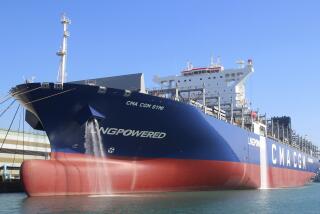The High-Tech Cole Was Highly Vulnerable
- Share via
While American and Yemeni investigators appear to be closing in on the identities of the two suicide bombers responsible for the apparent terrorist attack against the U.S. destroyer Cole, at least one important question has not been addressed: Why was such a state-of-the-art, sophisticated warship so vulnerable? How could a couple of men in a 20-foot boat have approached a guided missile destroyer--505 feet long and 8,600 tons--and inflicted so much damage?
Thus far, news reports have focused on the Cole’s price tag and advanced technology--a $1-billion, high-tech warship that boasts the gee-whiz Aegis combat system and was the shotgun of the fleet. But the damage sustained by the Cole was less about bells-and-whistles technology than about its structural strength--its intrinsic ability to sustain damage and remain operational.
Most news stories took only passing note of the thickness of the ship’s armored hull--a key determinant of its “survivability,” in Navy parlance. Indeed, the media have conveyed the false impression that only an exceptionally well-planned attack featuring advanced munitions could inflict a gaping 40-foot-by-45-foot breach in its hull.
In truth, American warships since World War II have been so lightly constructed that puncturing their sides is a fairly simple matter. An assailant has only to get close enough.
Battleships such as the Missouri, best known for hosting the Japanese surrender ceremony in 1945, represent the popular image of Navy surface warships. These floating citadels were built to withstand the one-ton (or greater) explosive projectiles meted out by enemy battleships and would have been impervious to an attack such as that carried out in Aden. As an example, both the Missouri and Wisconsin, which last saw action in the Gulf War, featured armored belts as thick as 17 inches at the waterline.
After World War II, however, the new military threat to the United States was no longer from enemy battleships, but rather from aircraft and anti-ship missiles deployed by the Soviet Union. This impelled naval architects to rely on high-tech air defenses to defeat enemy aircraft and anti-ship cruise missiles.
Newer warships, particularly those built from the 1960s on, would shoot down attacking aircraft and missiles before they could approach the fleet--or so U.S. military planners thought--and thus could be built without the luxury of armor plating. Lighter construction also restrained the escalating cost of warships and permitted greater fuel economy.
After reactivation during the Reagan defense buildup of the 1980s, the battleships were retired in the early 1990s, giving way to more technologically advanced ships. Aegis destroyers like the Cole are equipped with deadly anti-air missiles and a radar suite that far outstrips the capabilities of the battleships.
But these new warships, while in most respects more powerful than the Missouri and Wisconsin, lack the stout, low-tech armored sides that protected key areas of the battleships. The obsession with high-intensity naval warfare has left ships such as the Aegis destroyers, designed for battle on the open seas, vulnerable to low-end, unconventional threats such as terrorist bombings.
In 1987, the inadvertent Iraqi missile strike on the frigate Stark, in which the missile’s rocket booster actually ignited the flimsy aluminum superstructure and multiplied the damage, belied ship designers’ misguided faith in the invincibility of missile-armed warships. The Stark debacle prodded the Navy to insist on more rugged construction for the Aegis destroyers, then on the drawing board.
In fact, Aegis destroyers such as the Cole are the Navy’s premier surface warships and are the first ships since the 1950s built entirely of steel. Innovations such as the use of Kevlar (the lightweight substance used in bulletproof vests) to shield vital combat and propulsion systems represent a welcome improvement over surface ships built in recent decades.
Still, the Cole’s armored hull is a paltry half-inch thick, clearly inadequate to withstand any significant degree of punishment. The Navy continues to rely predominantly on advanced technology to offset threats and modern U.S. warships are ill-suited to resist even unsophisticated terrorist attacks.
As American investigators examine the wreckage and search out the culprits in the Cole attack, they should not automatically assume that the likes of Osama bin Laden, Saddam Hussein’s Iraq or a lavishly equipped, state-sponsored militant group such as Hezbollah are responsible.
Any number of splinter groups with access to explosives, a working knowledge of American naval procedures, a grudge against the United States and patience could have carried out the bombing. That covers a lot of ground.
More to Read
Sign up for Essential California
The most important California stories and recommendations in your inbox every morning.
You may occasionally receive promotional content from the Los Angeles Times.










